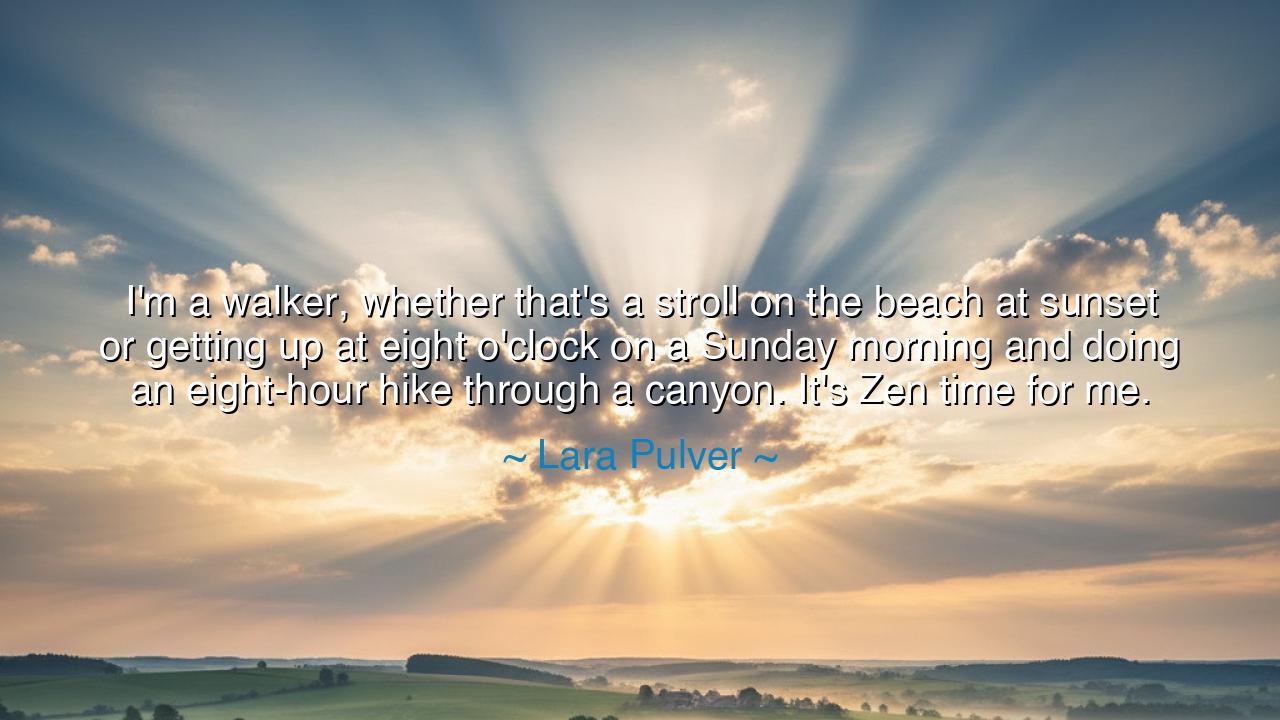
I'm a walker, whether that's a stroll on the beach at sunset or
I'm a walker, whether that's a stroll on the beach at sunset or getting up at eight o'clock on a Sunday morning and doing an eight-hour hike through a canyon. It's Zen time for me.






Hear the words of Lara Pulver, who spoke of her devotion to the path beneath her feet: “I’m a walker, whether that’s a stroll on the beach at sunset or getting up at eight o’clock on a Sunday morning and doing an eight-hour hike through a canyon. It’s Zen time for me.” At first these words seem like a gentle confession of habit, yet within them lies an ancient practice, as old as humankind itself—the wisdom of the road, the stillness found in motion, and the communion of body and soul with the earth.
The ancients revered the act of walking not only as travel but as meditation. The philosopher Aristotle taught while pacing beneath the colonnades, and his students were called Peripatetics—those who walk as they learn. The sages of the East, too, spoke of mindful steps, of the path that reveals itself one stride at a time. Pulver’s words echo this tradition: the beach at sunset, the canyon at dawn—these are no mere landscapes, but temples of reflection where the heart becomes quiet and the mind is cleansed.
To walk is to return to simplicity. The world demands swiftness: chariots in the ancient streets, machines in our modern age, yet walking rejects haste and honors presence. A stroll at sunset is more than leisure; it is a surrender to the beauty of the moment, the embrace of stillness within movement. And when Pulver speaks of an eight-hour hike through a canyon, she invokes the ancient pilgrim’s path, the long road that strips away distraction until only the self remains, face-to-face with silence, endurance, and wonder.
Consider the tale of the poet William Wordsworth, who wandered the English countryside for miles each day, composing verses as he walked. His poetry was not born in study alone, but in the rhythm of footsteps, in the communion with streams, fields, and sky. So too, Pulver calls her walking Zen time, for it is in the act of walking that she finds stillness, not in the absence of movement, but in its constancy—like the monk tracing circles in a garden, or the pilgrim ascending a mountain path.
Her words remind us also that walking bridges opposites: the stroll and the hike, the ease of gentle pace and the fire of endurance. Both are sacred, both reveal the same truth—that the path is the teacher. The slow step opens the heart to beauty; the long march opens the body to strength. Together, they form the complete ritual of the walker: gentleness and grit, reflection and resilience.
The lesson is clear: to walk is to return to balance. In every step, there is both motion and stillness, labor and rest. One does not need wealth or grandeur to find peace; the open road, the quiet shore, the winding canyon—these are gifts freely given to all. To make time for walking, whether at dawn or at sunset, is to reclaim the spirit from the noise of life and to plant it once more in the soil of presence.
Practically, each one of us may embrace this wisdom. Rise early and walk through your streets or fields. Seek nature’s paths on weekends, not as escape but as renewal. Let your mind wander as your feet move, and you will find that answers often come not in forced thought, but in the rhythm of steps. Make walking your own form of Zen time—a daily pilgrimage, no matter how short or long, into stillness within motion.
And so I say, O listener: embrace the path of the walker. Let your steps be prayers, your breath be rhythm, your gaze lifted to sky and earth alike. For whether in the golden glow of sunset or the rugged trials of a canyon, the road will give you what the world withholds: clarity, strength, and peace. Walk, and you will discover that every step is not a journey outward, but a journey inward, to the very heart of yourself.






AAdministratorAdministrator
Welcome, honored guests. Please leave a comment, we will respond soon